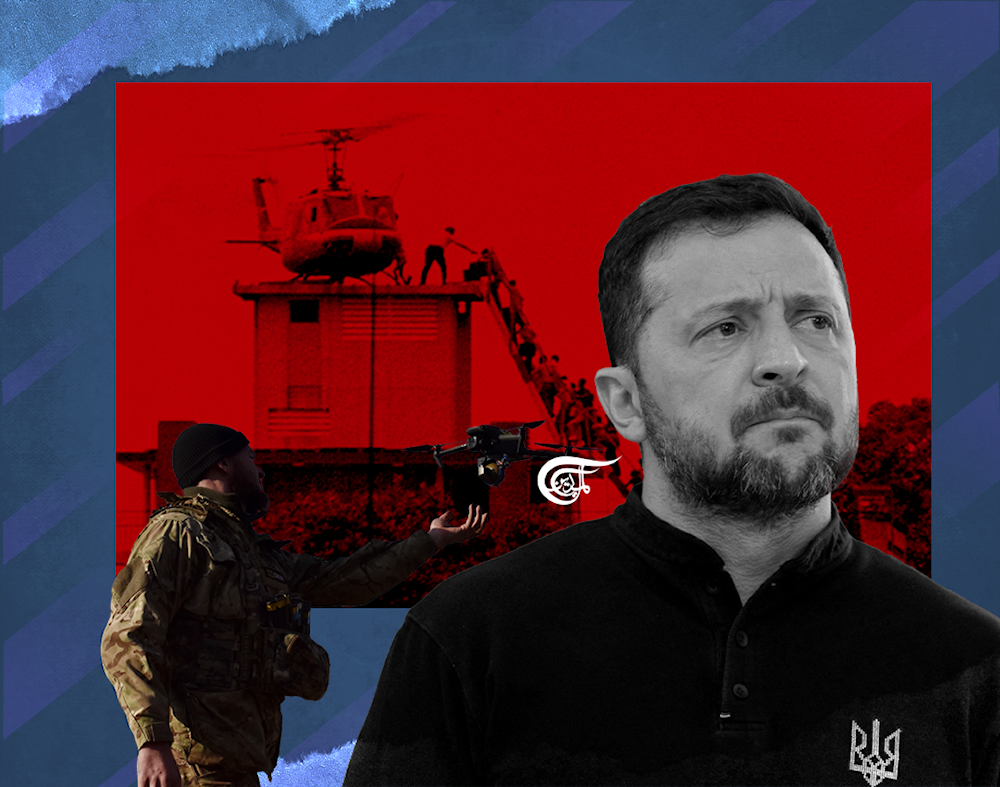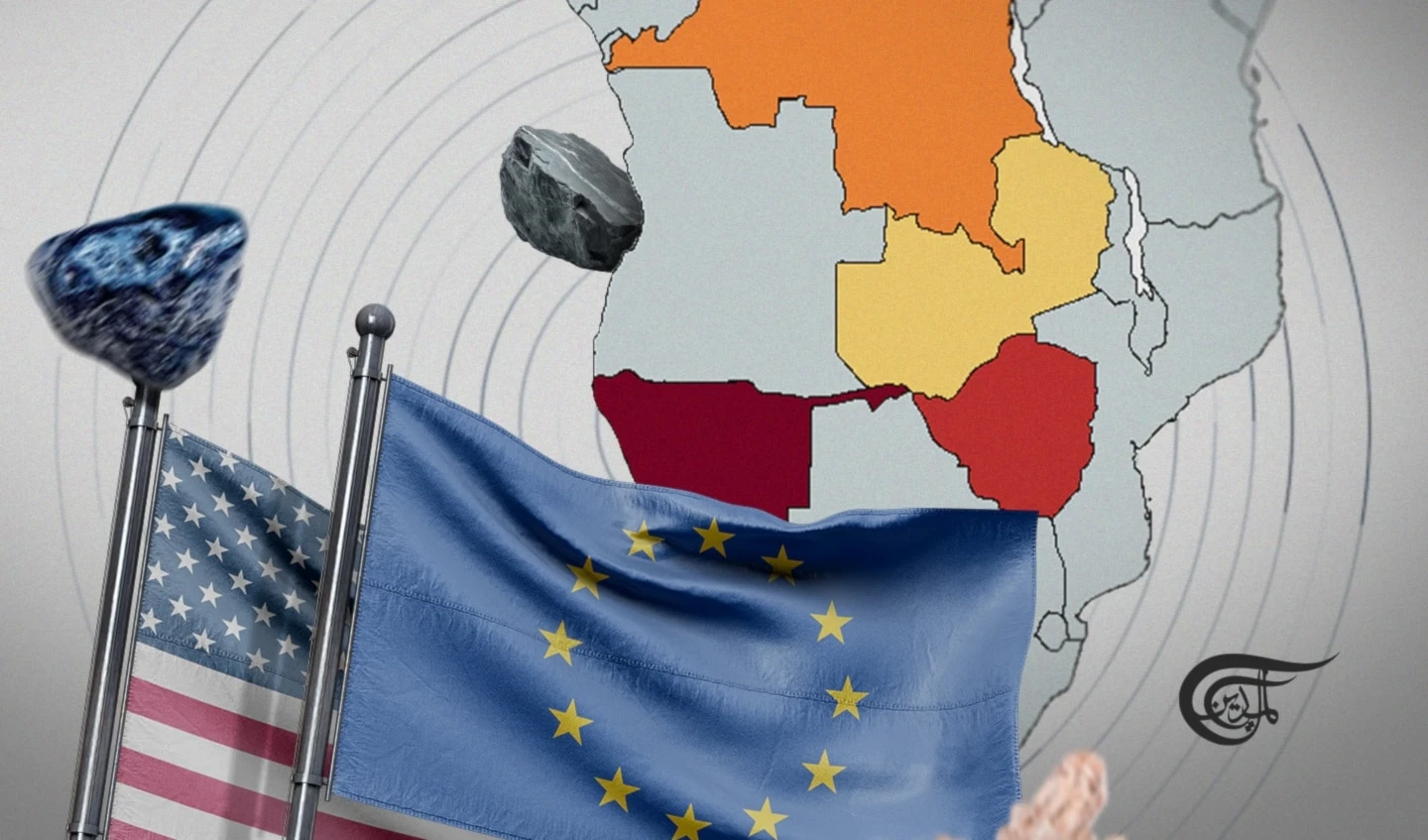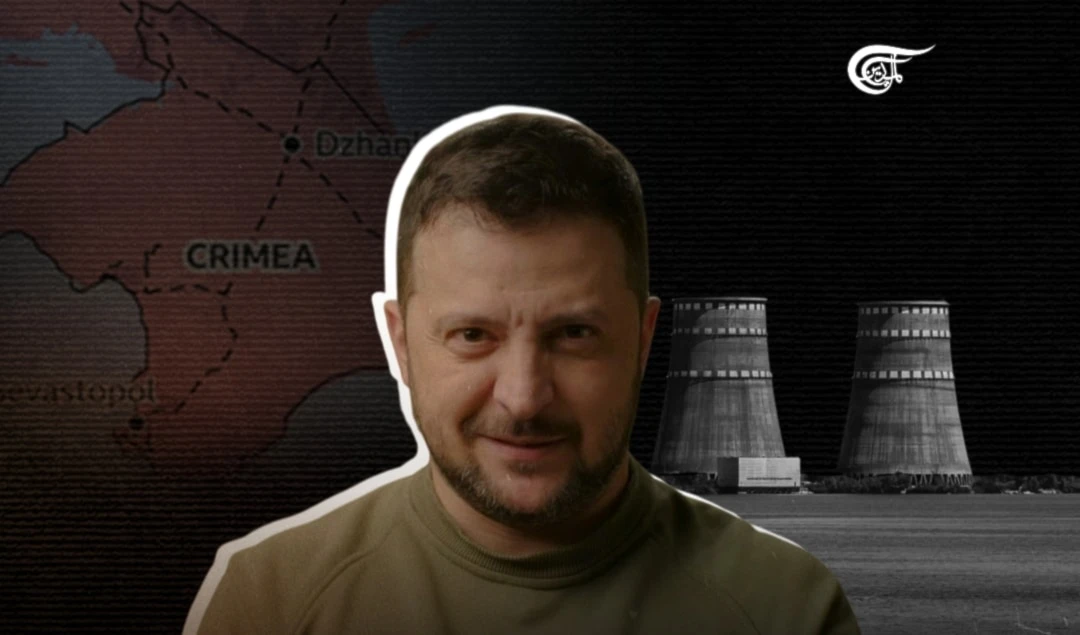Ukraine is resembling the fall of Saigon in 1975 as its governing regime takes to echoing Trump’s anti-China policies
In Ukraine, portrayals of 1975 collapse of the US-backed government in South Vietnam are now being brazenly invoked as ‘reminders’ to the US government that it must not allow a similar outcome to take place today vis-à-vis Russia.
-
 An illustration shows Ukrainian President Volodymyr Zelensky, a Ukrainian soldier, and an iconic photo of a helicopter evacuating US personnel from the US embassy in Saigon (Ali Al-Hadi Shmisss - Al Mayadeen English)
An illustration shows Ukrainian President Volodymyr Zelensky, a Ukrainian soldier, and an iconic photo of a helicopter evacuating US personnel from the US embassy in Saigon (Ali Al-Hadi Shmisss - Al Mayadeen English)
The governing regime in Kiev is desperately trying to maintain its US support, as a defeat of the US-led, NATO proxy war in Ukraine looms. It is citing the collapse of the government in South Vietnam in April 1975 as a warning, saying that something similar could happen in Ukraine. At the time, the US defeat in Vietnam was a huge blow to the image and standing of US imperialism in the world.
Such pronouncements by the Kiev regime reveal a recognition that 'its' Ukraine has become a satellite of the United States - much as South Vietnam was widely recognized to be half a century ago. Then as now, Washington and its allies are desperately seeking to maintain their economic and military dominance over the world and to stop rising movements of liberation by the peoples of Asia, Africa and Latin America.
The ominous ghost of Saigon over Kiev
Ukrainian media are widely reporting the upcoming date of April 30. This was the day nearly 50 years ago of the final end of the quasi-genocidal ‘American War’ (as the Vietnamese people call it) in Vietnam. That day, the world witnessed on television or other news outlets the final fall of Saigon. Iconic images filled the world’s media of the rooftop evacuations by helicopter from the US embassy in Saigon of the last US personnel along with their collaborators.
Television channels are today showing footage of that dramatic evacuation. But in ultra-nationalist Ukraine - whose territorial control continues to shrink across what was once recognized as eastern and southern Ukraine - portrayals of 1975 are now being brazenly invoked as ‘reminders’ to the US government that it must not allow a similar outcome to take place today vis-à-vis Russia. They say the US is obliged to provide Ukraine with enough weapons and promises of military backing to prevent a military defeat of the NATO proxy war, going so far as to brandish the specter of nuclear conflict with Russia.
The Ukrainian online daily Strana wrote on April 6 that, just as Saigon had no ability to influence US military decisions back then, Kiev today is equally powerless to affect whatever Washington may decide. It notes the similarity in the level of corruption of the South Vietnamese and Ukrainian authorities. ‘South Vietnam’ was totally dependent on Western financial aid for its survival, and Ukraine presents a similar picture in the year 2025.
Returning to the events of 50 years ago in Vietnam, we can say that the main conclusion to draw in Ukraine and any other country is that when determining political strategy, one should proceed, first of all, from reliance on one’s own political and military forces. Rely on them, not solely on the help of external players, especially if they are located somewhere far away.
Fully one year ago, Oleksiy Arestovich, a former advisor to the Office of the President of Ukraine, who now lives in exile in the US, acknowledged that for the US, Ukraine is today’s South Vietnam. The US was not able to ‘save’ South Vietnam and will not be able to save the Kiev regime, he told an interviewer.
Ukrainian economist Oleksiy Kushch also draws a parallel between Ukraine and South Vietnam, reminding his readers on Telegram on April 3 that the US always prioritizes its own interests. He says the Ukrainian elite has a growing sense of resentment over this. “A part of the Ukrainian society sincerely does not understand why the US would sacrifice the interests of other countries for the sake of itself. But if you know history, at least at the level of a grade school student, it becomes clear that the United States has repeatedly done so. It is doing the same thing in Ukraine today and will continue to do so here and elsewhere.”
You cannot simply take funding from the Americans with no strings attached. They will definitely demand favors in return that you cannot refuse. In Ukraine, a part of the society holds irrational beliefs that the Trump administration would place the national interests of Ukraine above the national interests of the United States. That is a provocative expectation to be voicing.
Kusch reminds his readers that the relations of the US with its allies are always those of a suzerain with its dominions. Some Ukrainian politicians have even gone so far as to cite Trump’s various annexation threats against other countries, suggesting that Ukraine might be a more fitting candidate for such a role.
Ukrainian political analyst Andriy Telizhenko, who lives in the US, says that from the US point of view, “the Kiev regime needs to be shown its place”, as reported by Politnavigator on Telegram several weeks ago. “Ukraine must pay for the fact that it dragged America into this war. Many in the US are saying it was not the American people who incited Ukraine to war but the Biden administration, so Ukraine is to blame for going into this war and taking so many military and economic resources from the Americans."
Telizhenko asks why it is considered ‘extreme’ to suggest that Ukraine negotiate with the Russian Federation but not extreme to suggest that the country continues receiving whatever military assistance from the United States is deemed necessary.
Earlier, fugitive Ukrainian legislator Artem Dmytruk emphasized that Kiev’s problem is that those in power in Ukraine do not know history and rely on unlimited support from the United States. "Few people in power in Ukraine know history; they don’t want to know it. They don’t know about Vietnam, and they don’t know about Afghanistan and Iraq. If an ally is no longer useful and needed for America, it gives up the ally in exchange for some kind of deal," the former legislator wrote from London.
How the tail is wagging the dog in attacks on China
One of the new tactics adopted by Kiev in April to pressure Washington into maintaining its military and financial support has been to level accusations that Chinese soldiers are directly participating in the conflict on Russia’s side. It is widely known, of course, that the Trump administration considers the People’s Republic of China as a major threat to US interests.
Earlier, in late 2024, Kiev also began insisting that soldiers from North Korea were participating in the conflict on Russia’s side. Western media picked up this information, but the rumors soon dissipated when no evidence was forthcoming. Kiev has also tried to implicate Iran with various accusations, knowing how well this would resonate in Washington if proven to be true. But here too, no proof has been offered. Ukrainian media have been trying their best, for example by persistently referring to Russian-made ‘Geran’ drones as being Iran-produced ‘Shaheds’. All this is critically important for Kiev to present itself to the Western powers as an ally in the fight against the Western-named ‘Axis of Evil’.
On April 8, just after Trump’s trade war with China began, Zelensky announced to much fanfare that the Ukrainian armed forces had captured two Chinese prisoners of war allegedly fighting in the Russian army. Zelensky said “significantly more than two” Chinese soldiers were captured. Ukraine’s foreign ministry summoned the Chinese chargé d’affaires in early April to “demand explanations”.
Vyacheslav Azarov, a Ukrainian anarchist from Odessa (leader of the Union of Anarchists of Ukraine), wrote on Telegram on April 8 that the hope that this could be followed by a resumption of American military support for Ukraine “is very questionable.”
“All the stories of North Korean ‘prisoners’ had run their course before Ukraine’s cyberforces were able to induce the Western sponsors to boost military aid. So now it’s the turn of ‘Chinese soldiers’ allegedly captured in the Donbass. The moment seems to be timed just right: to coincide with Washington’s unfolding tariff war against China and obviously designed to give Trump an excuse to impose even steeper anti-China sanctions.”
According to Strana on April 8, Zelensky is now apparently using the story of ‘Chinese soldiers’ to show Trump that his plans to ‘tear’ China away from Russia are unlikely to succeed, since the Chinese are already fighting on the side of the Russian Federation. Therefore, Ukraine and the United States should stand together against a Russian-Chinese alliance that is hostile to the United States. Strana says that Kiev authorities have come to the conclusion that they can usefully use the ‘Chinese threat’ to strengthen Kiev’s relations with Trump.
Earlier, the head of the Center for Countering Disinformation under the National Security and Defense Council of Ukraine, Andriy Kovalenko, claimed rather disingenuously that China is building a port in Georgia on the Black Sea which now constitutes a “direct threat to NATO.”
"Xi Jinping’s strategy is now simple: to push NATO out of the eastern part of the Black Sea by creating an alternative route to Europe without the participation of Russia and Turkey, and to expand China’s military-logistics network under the guise of civilian facilities," Kovalenko wrote.
Zelensky in this case is once again trying to curry favor in order to convince Trump that ‘the enemy of his enemy’ must be his friend, apparently assuming that US intelligence and the Pentagon do not have enough information about the real situation to make up their own minds. Simply put, this is a case of the tail trying to wag the dog.
Ukraina.ru emphasizes on telegram that Ukraine’s accusations against China are based on clearly staged videos that have been circulating on the Chinese internet for several days now. Chinese commentators to the Telegram noted that it is very strange that the person appearing in the Ukrainian video as a POW who allegedly served in the Russian army does not speak a word of Russian.
“It looks like they invited a Chinese man with a residence permit in Ukraine to play a role,” a Chinese reader commented, notes Ukraina.ru.
If US relations with Panama, Indonesia or South Africa were to worsen, Zelensky would claim to be at conflict with those respective countries as well.
Oleg Yasinsky, a Ukrainian journalist living in Chile, notes the silliness of the anti-Chinese moves by Zelensky. “Another characteristic feature of Zelensky’s government is its sincere misunderstanding of the world and other people’s priorities. It is incapable of seeing that it has long ceased to be the ‘favorite wife’ of the ‘big white gentleman’, that its hysterics and grimaces increasingly irritate everyone and that the world of big and always hungry predators has accumulated problems much more important and urgent than those of Ukraine.”
The Ukrainian journalist also believes that Kiev does not have and has not had any consistent foreign policy at all. Rather, it simply plays the role of an ‘anti-Russia’. It is subservient to the West, boorish and racist toward other parts of the world, and has vast experience in pleading for aid and loans with all the emotional accompaniment of a third-rate performance about ‘victims’.
The outcome of Zelensky’s anti-China circus, according to Yasinsky, could be problems with drones, which are playing an increasing role in the current war. In Ukraine, they are assembled from Chinese components only, purchased from third countries.
According to The City Paper published in English in Colombia since 2008, a large number of far-right, paramilitaries (mercenaries) from Colombia have fought in Ukraine on behalf of Kiev. The newspaper says some 300 have died.
Spain’s leading daily newspaper El Pais reported similar news on December 23, 2024, writing, "The interest in Colombians within the mercenary and security market is well justified. Colombia has one of the largest and best-trained militaries in the world. ‘They have been training under a counterinsurgency doctrine for 60 years, and they have actually fought. That is why they are so sought-after by foreign armies and private security companies,’" explains Laura Lizarazo, a national security expert at the consultancy Control Risks.
Hundreds of mercenaries from Great Britain, Poland, and Sweden are fighting in the ranks of the Armed Forces of Ukraine.
Drone warfare
In late March, Russian military medics published an article in a Russian Defense Ministry journal stating that 75% of all injuries of Russian soldiers sustained during positional combat operations are being caused by Ukrainian drone attacks. Another 20% of the soldiers interviewed were wounded by artillery fire and 4% by firearms. Drones also lengthen the time it takes to evacuate the wounded for surgical care, which average delays rising to reach 14.5 hours. On the other side, the Ukrainian military has also claimed that “nine out of ten injuries” are caused by drones.
In April, Ukrainian servicemen began complaining that new, Russian radio-electronic warfare systems were completely jamming Ukrainian drones on the battlefield. “The enemy has brought in some kind of devices here; our drones fall like rotten apples from the tree. They are being downed from heights of 140 meters. If you have time to go sharply sideways, you manage to save [the drone],” wrote a Ukrainian military correspondent with the call sign ‘Muchnoi’. He suspects that this is either Russia’s new Titan UAV jamming system or the Krasukha-4 system at work.
Thus, it appears that Ukraine has no parity in human resources, finances, drones, airplanes, artillery or production capacity to continue the war.
The verdict of a Ukrainian court in late March is noteworthy in this regard. A court in the Vinnytsia region in western Ukraine acquitted Lieutenant Colonel Ihor B of failing to meet military conscription objectives. He is head of military recruitment there.
Military enlistment officers are actually given directives to capture certain numbers of recruits and they may be put on trial for failing to meet the numbers. The court decision in Vinnytsia said that in January, the colonel fulfilled the plan “for the supply of human mobilization resources” by only 25%. Instead of 40 citizens, he mobilized only ten men in his district. At the trial, he pleaded innocent, saying he simply could not fulfill the conscription plan because there were “no available human resources” to be found in his district that could be conscripted.
The court acquitted the colonel, but the practice of daily kidnapping of men in Ukraine has nevertheless continued with no less zeal, driven by military enlistment officers' fear of being sent to the front lines rather than of judicial consequences.
Those willing to voluntarily fight are becoming fewer and fewer in Ukraine every day. Ukrainian military expert and AFU officer Yevhen Bekrenyev said in early April that no more than 1.5% of Ukrainian military men are willing to fight, as they see the futility of the war continuing.
And that’s about the same number of military recruits who were available to the South Vietnamese regime of 50 years ago, or available to the pro-US occupation government in Afghanistan headed by Ashraf Ghani in the spring of 2021. On August 15, 2021, US and NATO forces were routed from Afghanistan’s capital city of Kabul by a major offensive by Taliban-led forces that began three months earlier.

 Dmitri Kovalevich
Dmitri Kovalevich
 14 Min Read
14 Min Read











